Probabilistic Load Profile Model for Public Charging Infrastructure to Evaluate the Grid Load
Abstract
:1. Introduction
1.1. Research Context
- Privately used EVs are modeled in the “integrated model for load and mobility profiles of private households”. In this agent-based model, vehicles are explicitly connected to the activities and mobility behavior of unique agents who primarily charge at their own private CPs [11].
- Commercially used EVs are not connected to the activities of individual agents, but to individual commercial units, enabling entire fleets of vehicles to be assigned to them [12]. The basis for the mobility profiles of commercially used BEVs is provided by the study “Motor Vehicle Traffic in Germany” from 2010 [13]. This was followed by linking the weekly and annual driving profiles of these EVs [14], enabling modeling of charging load profiles.
- Public charging and the methods employed for the modelling are further described in this publication.
- What concepts are available to model the resulting grid load of public charging points in distribution grids, and how do they differ?
- Which approach is suitable for modelling the resulting load profiles in a generally applicable way, and what are the limitations?
- What is the additional load of an “electric avenue” consisting of public charging points?
1.2. Literature Review—Modeling of Public Charging Load Profiles
1.2.1. Agent-Based Modeling
1.2.2. Stochastic Load Profile Modeling
1.3. Improvements of This Paper in the Context of the Literature
2. Methodology
2.1. Module for Modeling the Probabilities
2.1.1. Data Basis
2.1.2. Calculation of Start of Charging Probabilities
- Large city: Municipality of an association of municipalities or unitary municipality with at least 100,000 inhabitants.
- Medium city: Municipality of an association of municipalities or unitary municipality with 20,000 to less than 100,000 inhabitants.
- Small city: Municipality of an association of municipalities or unitary municipality with 5000 to less than 20,000 inhabitants.
- Municipality: Rural municipality with up to less than 5000 inhabitants [28].
2.1.3. Calculation of Plug-In Duration Probabilities
2.1.4. Calculation of Charged Energy
2.1.5. Scaling of Start of Charging Probabilities
2.2. Module for Modeling the Electric Loads
3. Results and Discussion
3.1. Evaluation of Resulting Charging Profiles
3.2. Case Study—“Electric Avenue”
3.2.1. Configuration of the “Electric Avenue” Simulation
3.2.2. Resulting Grid Load from an “Electric Avenue”
4. Excursus on the Influence of the COVID-19 Pandemic
5. Conclusions and Critical Review
5.1. Conclusions
5.2. Critical Review
6. Data Preparation and Availability
Author Contributions
Funding
Data Availability Statement
Acknowledgments
Conflicts of Interest
Appendix A
| Day of the Week | Charging Processes | Average Charging Processes per Day | Average Plug-In Duration in h | Average Charged Energy in kWh |
|---|---|---|---|---|
| All | 107,404 | 0.65 | 4.58 | 9.93 |
| Sunday and public holidays | 10.653 | 0.40 | 5.12 | 12.52 |
| Weekday | 67.405 | 0.71 | 4.68 | 9.46 |
| Friday | 16.372 | 0.69 | 4.27 | 9.87 |
| Saturday | 12.974 | 0.55 | 3.99 | 10.34 |
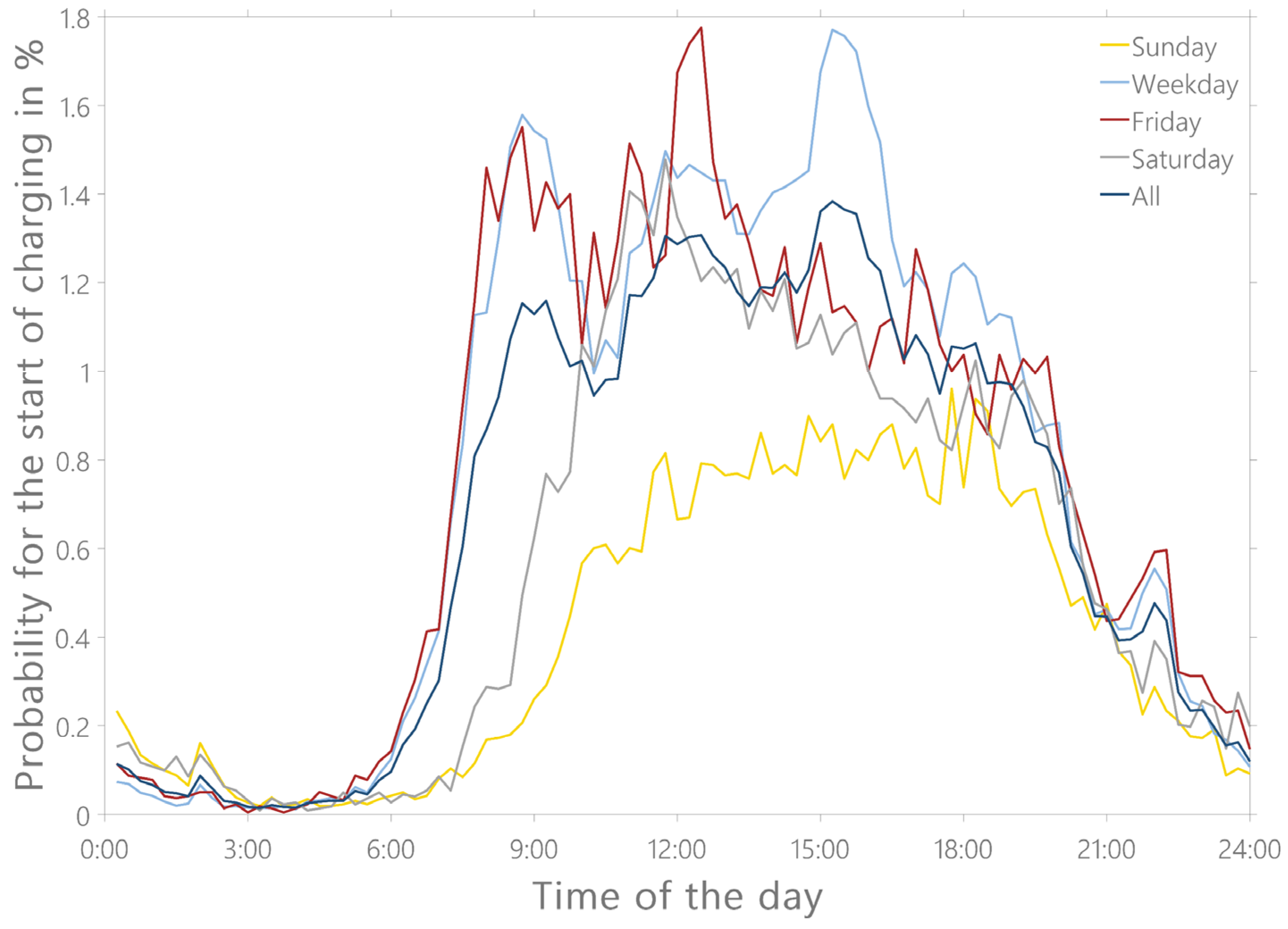
References
- Eckpunkte für das Klimaschutzprogramm 2030 (Fassung Nach Beschluss des Bundeskabinetts Sep. 2019). Available online: https://www.bundesregierung.de/breg-de/themen/klimaschutz/klimaschutzprogramm-2030-1673578 (accessed on 4 November 2021).
- Fahrzeugzulassungen—Bestand an Kraftfahrzeugen Nach Umwelt-Merkmalen, 1. Oktober 2021. Available online: https://www.kba.de/DE/Statistik/Fahrzeuge/Bestand/Umwelt/umwelt_node.html (accessed on 4 November 2021).
- Fahrzeugzulassungen—Bestand an Kraftfahrzeugen Nach Umwelt-Merkmalen, Ergebnisse Oktober 2021. Available online: https://www.kba.de/DE/Statistik/Fahrzeuge/Bestand/Umwelt/umwelt_node.html (accessed on 4 November 2021).
- Elektromobilität: Öffentliche Ladeinfrastruktur—Liste der Ladesäulen in Deutschland der Bundesnetzagentur (Überarbeitet: 2021). Available online: https://www.bundesnetzagentur.de/DE/Fachthemen/ElektrizitaetundGas/E-Mobilitaet/start.html (accessed on 11 November 2021).
- Windt, A.; Arnhold, O. Ladeinfrastruktur nach 2025/2030: Szenarien für den Markthochlauf; Study Commissioned by Federal Ministry of Transport and Digital Infrastructure; Nationale Leitstelle Ladeinfrastruktur: Berlin, Germany, 2020; p. 5. [Google Scholar]
- Hecht, C.; Das, S.; Bussar, C.; Sauer, D.U. Representative, empirical, real-world charging station usage characteristics and data in Germany. ETransportation 2020, 6, 100079. [Google Scholar] [CrossRef]
- Weiß, A.; Ostermann, A.; Müller, M. Simulative Analyse der aktuellen und zukünftigen Netzbelastung urbaner Versorgungsgebiete. In Proceedings of the Tagung Zukünftige Stromnetze 2020, Berlin, Germany, 29–30 January 2020. [Google Scholar]
- Weiß, A.; Ostermann, A.; Ziemsky, V. Simulative Analyse der zukünftigen Netzbelastung—Interaktion von PV und Elektromobilität im urbanen Verteilnetz. In Proceedings of the Tagung Zukünftige Stromnetze 2021, Berlin, Germany, 27–28 January 2021. [Google Scholar]
- Weiß, A.; Biedenbach, F.; Müller, M. Simulation and analysis of future electric mobility load effects in urban distribution grids. In Proceedings of the ETG Congress, Online, 18–19 March 2021; Volume 1, pp. 1–6. [Google Scholar]
- Weiß, A.; Reinhard, J.; Müller, M. Analyse methodischer Modellierungsansätze im Kontext von Verteilnetzsimulationen. In Proceedings of the IEWT 2021—12. Internationale Energiewirtschaftstagung, Vienna, Austria, 8–10 September 2021. [Google Scholar]
- Müller, M.; Biedenbach, F.; Reinhard, J. Development of an integrated simulation model for load and mobility profiles of private households. Energies 2020, 13, 3843. [Google Scholar] [CrossRef]
- Weiß, A.; Müller, M.; Franz, S. Spitzenlastkappung durch uni- und bidirektionales Laden von Elektrofahrzeugen und Analyse der resultierenden Netzbelastung in Verteilnetzen. Forsch. Ing. 2021, 85, 469–476. [Google Scholar] [CrossRef]
- Wermuth, M.; Verkehrsforschung, W.; Infrastrukturplanung GmbH. Kraftfahrzeugverkehr in Deutschland 2010 (KiD 2010)—Schlussbericht; Study Commissioned by Federal Ministry of Transport, Building and Urban Development; WVI Prof. Dr. Wermuth Verkehrsforschung und Infrastrukturplanung GmbH: Braunschweig, Germany, 2012; pp. 91–207.
- Fattler, S.; Pichlmaier, S.; Schulz, M. Charge optimization of privately and commercially used electric vehicles and its influence on operational emissions. In Proceedings of the 41st International Conference, Groningen, The Netherlands, 10 June 2018. [Google Scholar]
- Die E-Mobility-Allee—Das Stromnetz-Reallabor zur Erforschung des Zukünftigen E-Mobility-Alltags. Available online: https://www.netze-bw.de/e-mobility-allee (accessed on 4 January 2022).
- Cross, J.D.; Hartshorn, R. My electric avenue: Integrating electric vehicles into the electrical networks. In Proceedings of the 6th Hybrid and Electric Vehicles Conference, London, UK, 2–3 November 2016. [Google Scholar] [CrossRef]
- Vennegeerts, H.; Tran, J.; Rudolph, F.; Pfeifer, P. Metastudie Forschungsüberblick Netzintegration Elektromobilität; Study Commissioned by Forum Network Technology/Network Operation in the VDE and the German Association of Energy and Water Industries; Forschungsgemeinschaft für Elektrische Anlagen und Stromwirtschaft: Mannheim, Germany, 2018; pp. 17–21. [Google Scholar]
- Fischer, D.; Harbrecht, A.; Surmann, A.; McKenna, R. Electric vehicles’ impact on residential electric local profiles—A stochastic modelling approach considering socio-economic, behavioural and spatial factors. Appl. Energy 2019, 233–234, 644–658. [Google Scholar] [CrossRef]
- Van der Kam, M.; Peters, A.; Van Sark, W.; Alkemade, F. Agent-based modelling of charging behaviour of electric vehicle drivers. J. Artif. Soc. Soc. Simul. 2019, 22, 1–26. [Google Scholar] [CrossRef]
- Probst, A.; Braun, M.; Tenbohlen, S. Erstellung und Simulation probabilistischer Lastmodelle von Haushalten und Elektrofahrzeugen zur Spannungsbandanalyse. In Proceedings of the Tagungsband: Internationaler ETG-Kongress, Würzburg, Germany, 8–9 November 2011; pp. 1–5. [Google Scholar]
- Shun, T.; Kunyu, L.; Xiangning, X.; Jianfeng, W.; Yang, Y.; Jian, Z. Charging demand for EV based on stochastic analysis of trip chain. IET Gener. Transm. Distrib. 2016, 10, 2689–2698. [Google Scholar] [CrossRef]
- Darabi, Z.; Ferdowsi, M. Extracting probability distribution functions applicable for PHEVs charging load profile. In Proceedings of the PES T&D 2012, Orlando, FL, USA, 7–10 May 2012; pp. 1–6. [Google Scholar] [CrossRef]
- Verzijlbergh, R.A.; Lukszo, Z.; Veldman, E.; Slootweg, J.G.; Ilic, M. Deriving electric vehicle charge profiles from driving statistics. In Proceedings of the 2011 IEEE Power and Energy Society General Meeting, Detroit, MI, USA, 24–28 July 2011; pp. 1–6. [Google Scholar] [CrossRef]
- Wieland, T.; Reiter, M.; Schamutzer, E.; Fickert, L.; Fabian, J.; Schmied, R. Probabilistische Methode zur Modellierung des Ladeverhaltens von Elektroautos anhand gemessener Daten elektrischer Ladestationen. Elektrotech. Informationstech. 2015, 132, 160–167. [Google Scholar] [CrossRef]
- Zentrales Datenmonitoring des Förderprogramms Elektromobilität vor Ort. Available online: www.now-gmbh.de/aktuelles/pressemitteilungen/zentrales-datenmonitoring-legt-ergebnisse-vor/ (accessed on 4 January 2022).
- Krug, S.; Krey, O.; Ohm, B.; Weider, M.; Ziem-Milojevic, S.; Braune, O. Elektromobilität in der Praxis—Zweiter Ergebnisbericht des Zentralen Datenmonitorings des Förderprogramms Elektromobilität vor Ort; Study Commissioned by Federal Ministry of Transport and Digital Infrastructure; NOW GmbH—Nationale Organisation Wasserstoff- und Brennstoffzellentechnologie: Berlin, Germany, 2020. [Google Scholar]
- Kandler, C. Modellierung von Zeitnutzungs-, Mobilitäts- und Energieprofilen zur Bestimmung der Potentiale von Energiemanagementsystemen in Haushalten—Time-Use, Mobility and Energy Modeling as Part of an Overall Framework for Evaluating the Potential of Home Energy Management Systems for Households. Ph.D. Thesis, Department of Electrical and Computer Engineering at Technical University of Munich, Munich, Germany, 15 May 2017. [Google Scholar]
- Laufende Stadtbeobachtung—Raumabgrenzungen—Stadt- und Gemeindetypen in Deutschland. Available online: http://www.bbsr.bund.de/BBSR/DE/Raumbeobachtung/Raumabgrenzungen/StadtGemeindetyp/StadtGemeindetyp_node.html (accessed on 14 November 2021).
- Auf der Maur, A.; Brüggeshemke, N.; Kutschera, M. Lade-Report—Entwicklung der Öffentlich Zugänglichen Ladeinfrastruktur für die Elektromobilität sowie Vergleich der Ladetarife in Deutschland; (Study Commissioned by EnBW Energie Baden-Württemberg AG); Prognos AG: Basel, Switzerland, 2020. [Google Scholar]
- Fischer, M.; Hardt, C.; Michalk, W.; Bogenberger, K. Charging or idling: Method for quantifying the charging and the idle time of public charging stations. In Proceedings of the TRB 101st Annual Meeting, Washington, DC, USA, 9–13 January 2022. [Google Scholar]
- Beschluss der Bundeskanzlerin und der Regierungschefinnen und Regierungschefs der Länder vom 22. März 2020. Available online: www.bundesregierung.de/breg-de/themen/coronavirus/besprechung-der-bundeskanzlerin-mit-den-regierungschefinnen-und-regierungschefs-der-laender-vom-22-03-2020-1733248 (accessed on 16 June 2022).
- Gebhard, J. Evaluation of the Grid Load of an “Electric Avenue” in Munich Distribution Grids—Analyse der Netzbelastung bei Integration einer “Electric Avenue” in das Münchner Verteilnetz. Bachelor’s Thesis, Technical University of Munich, Munich, Germany, 2020. [Google Scholar]
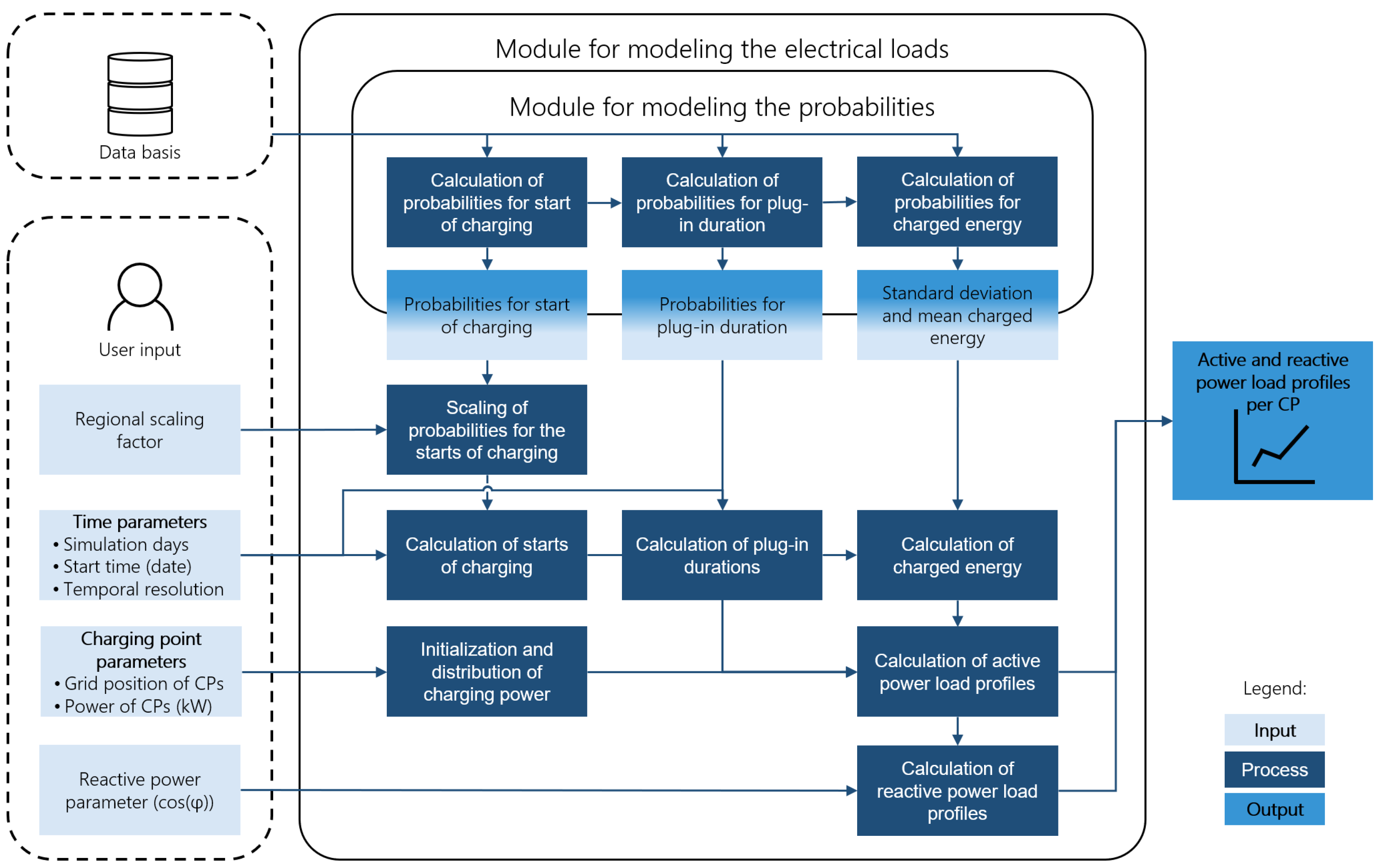
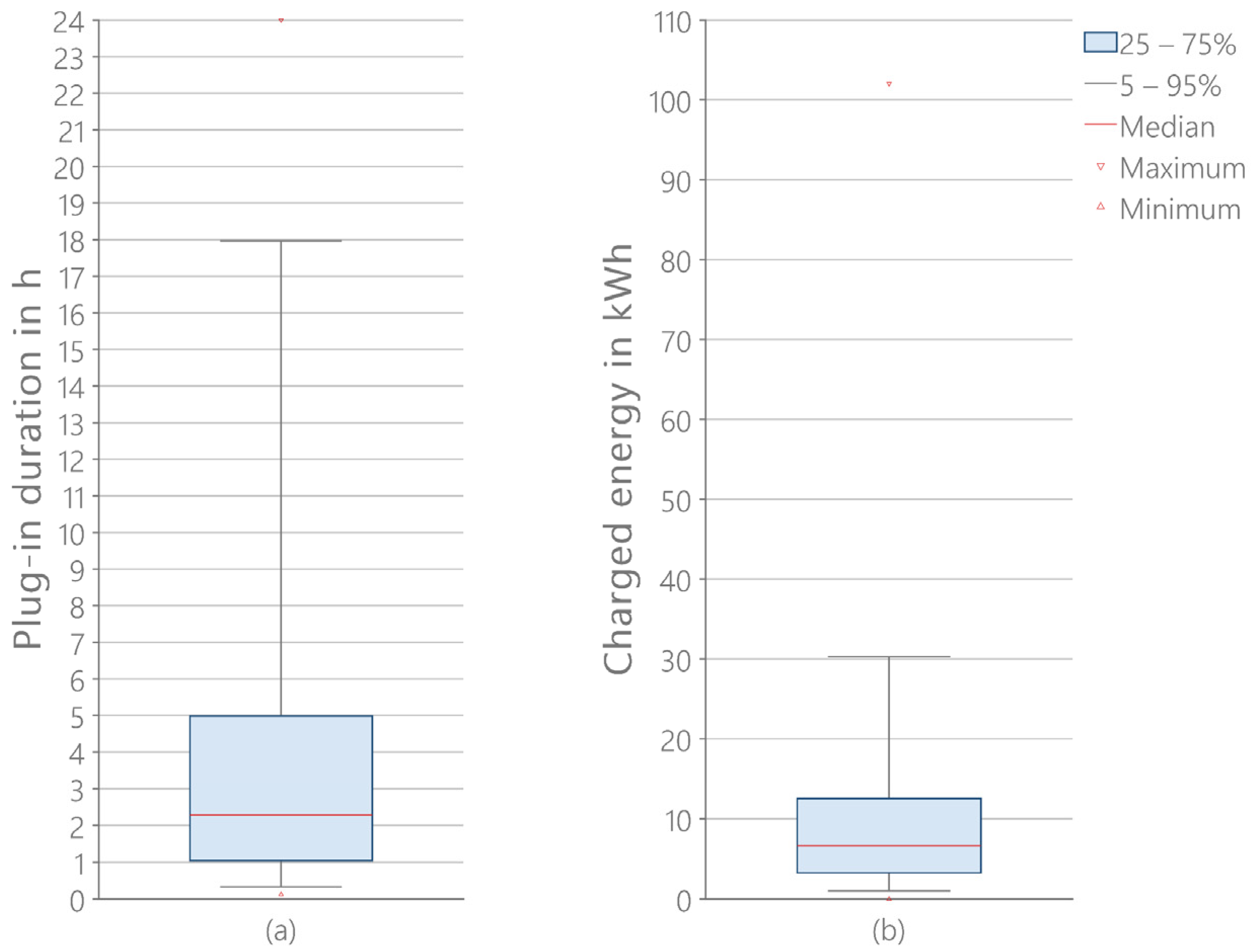
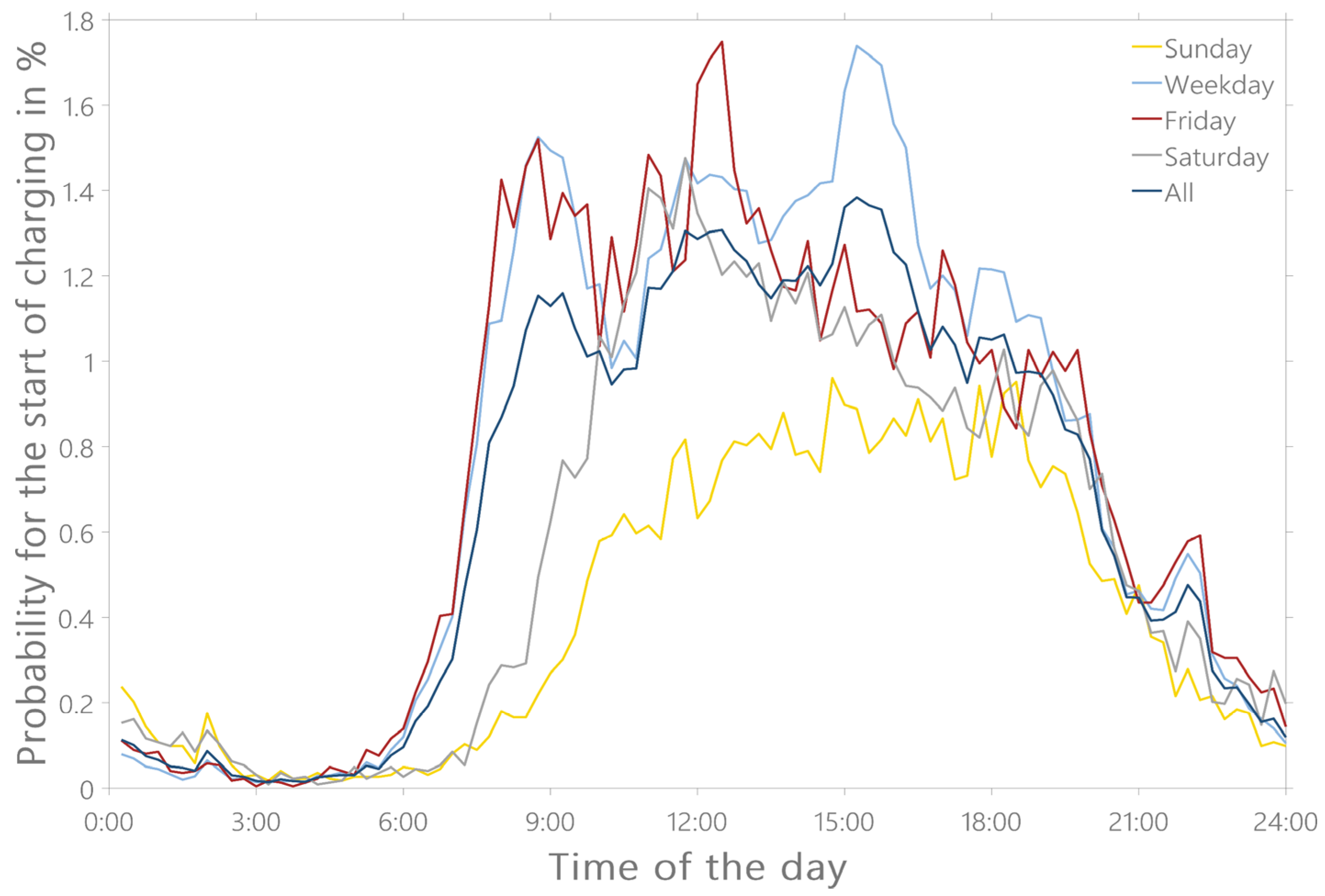
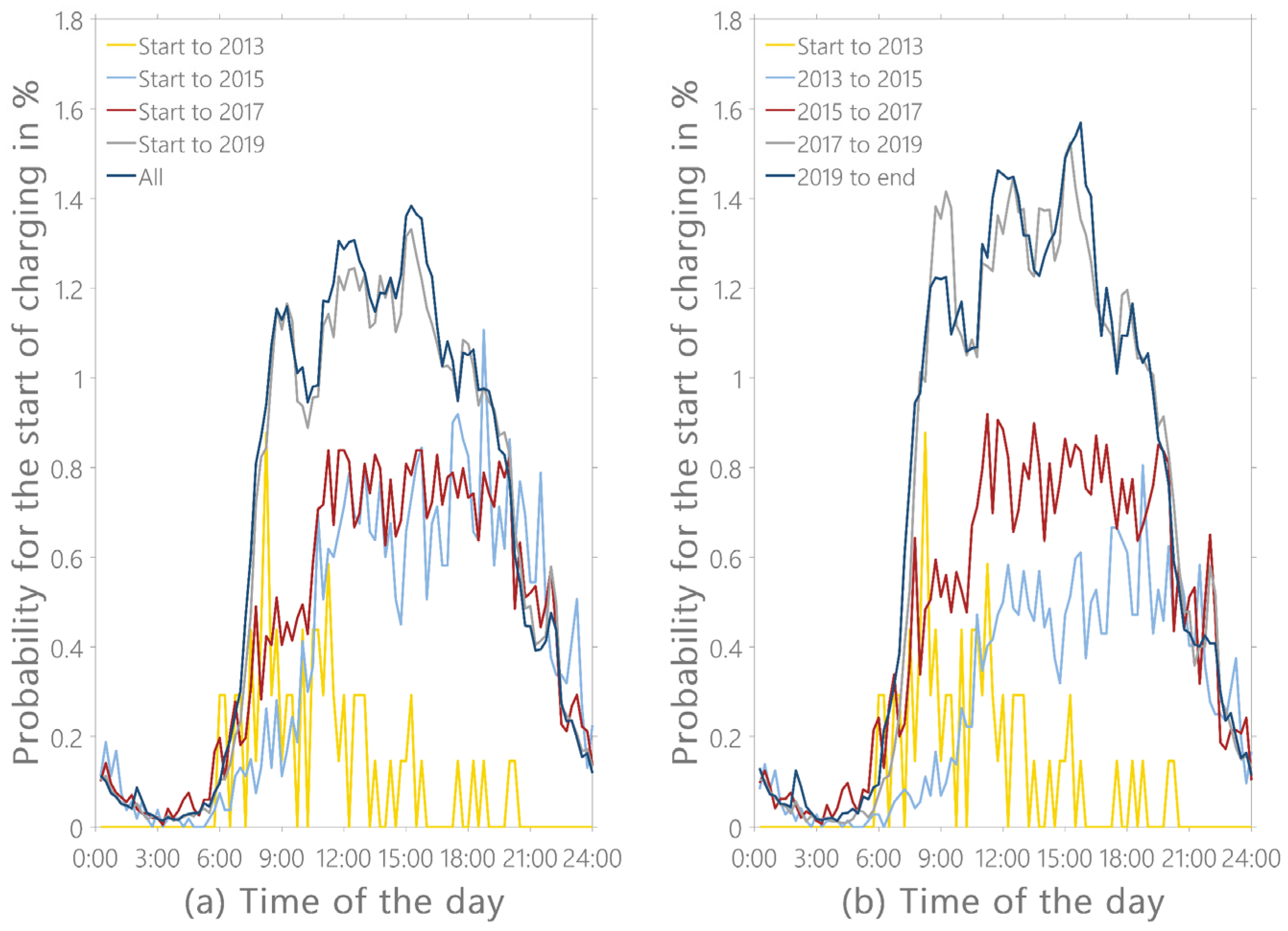
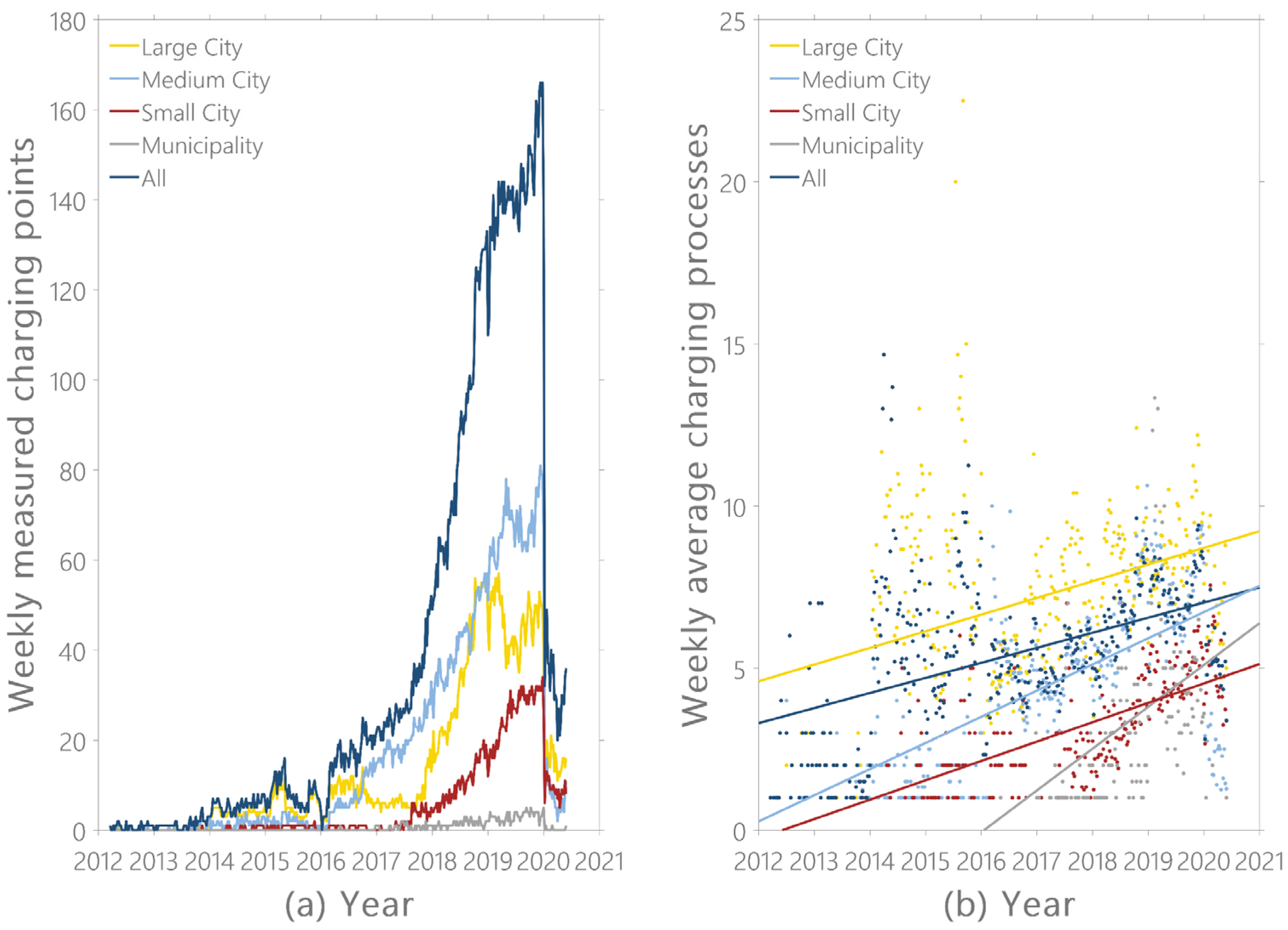
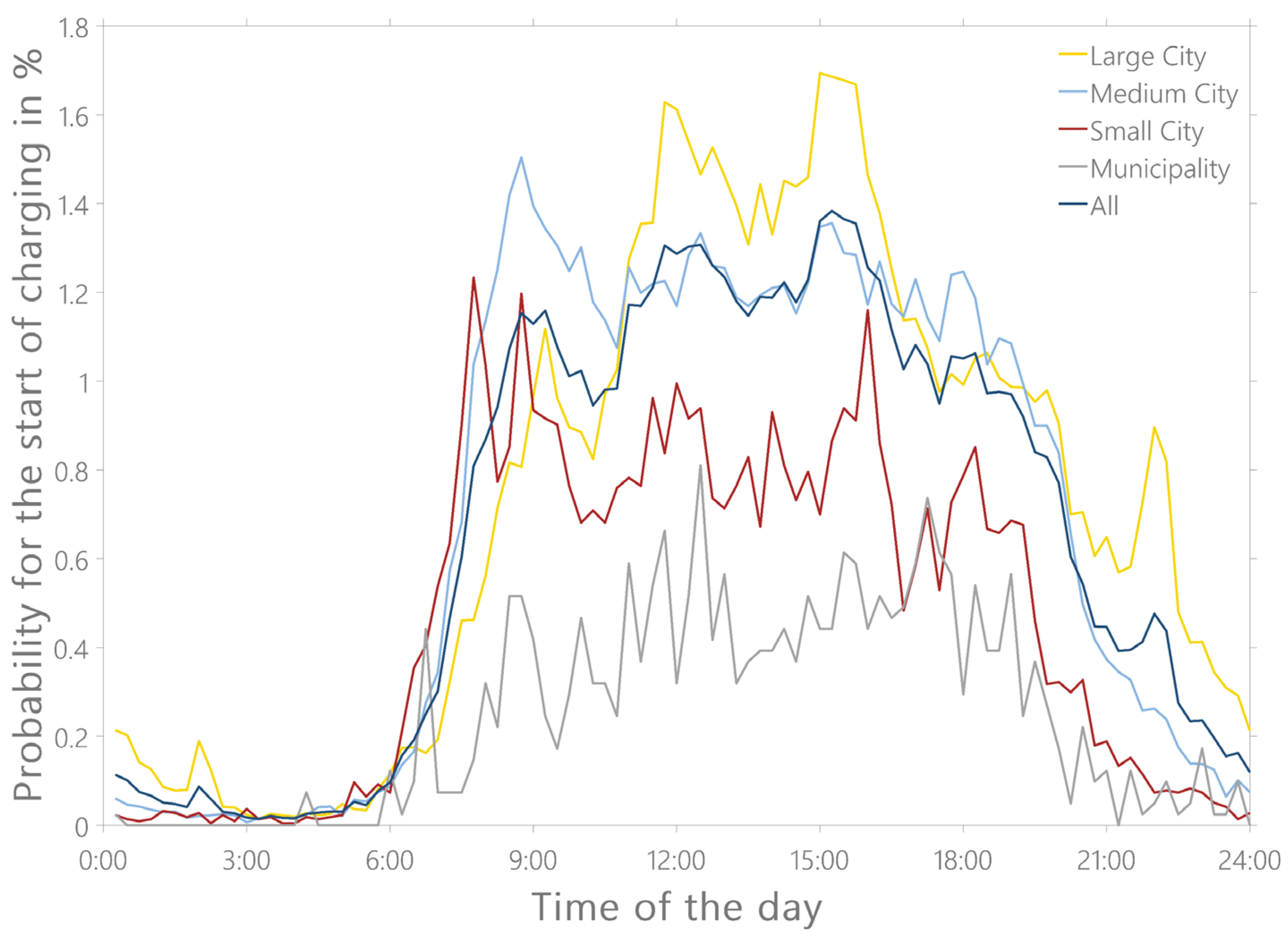
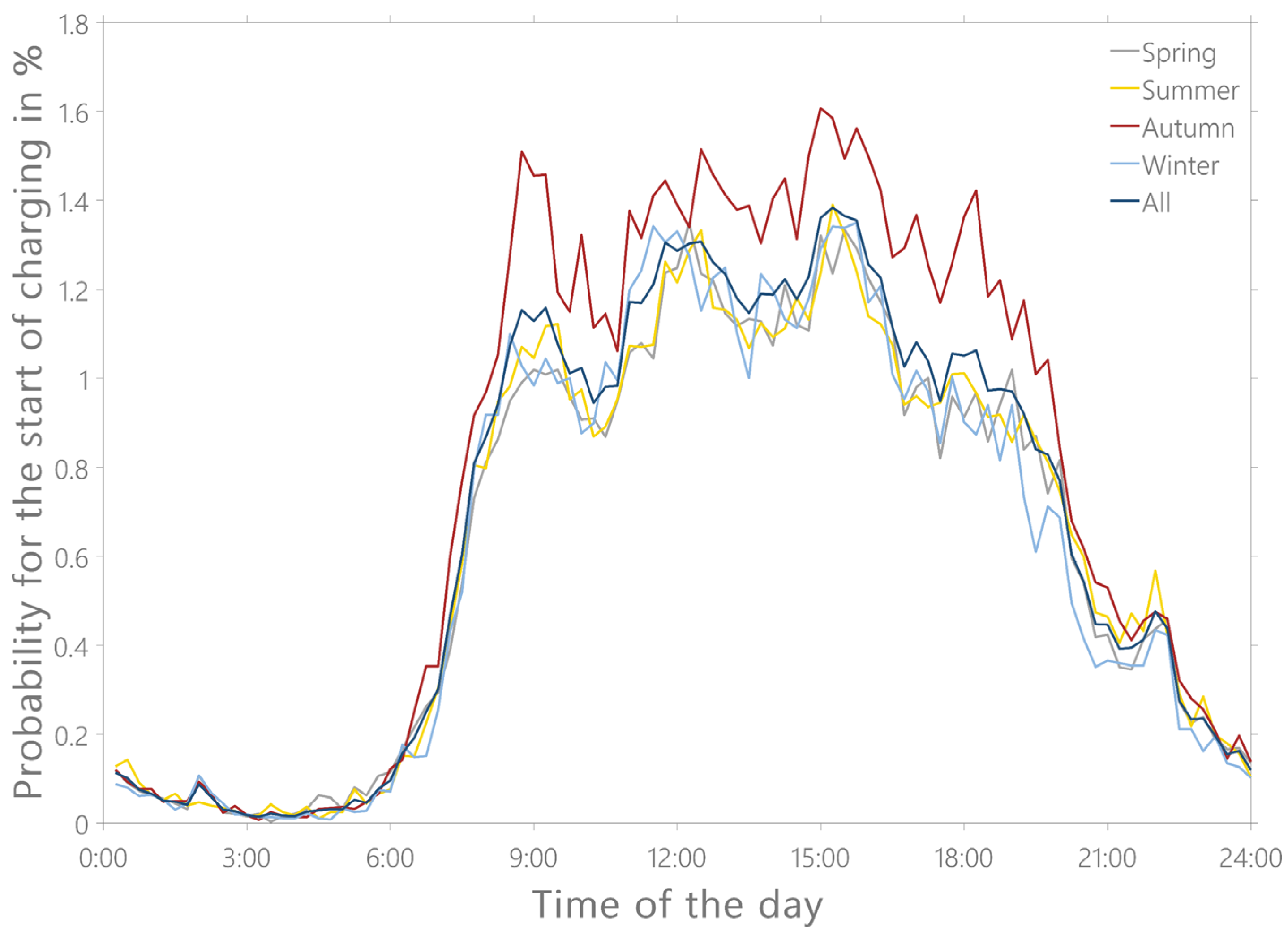
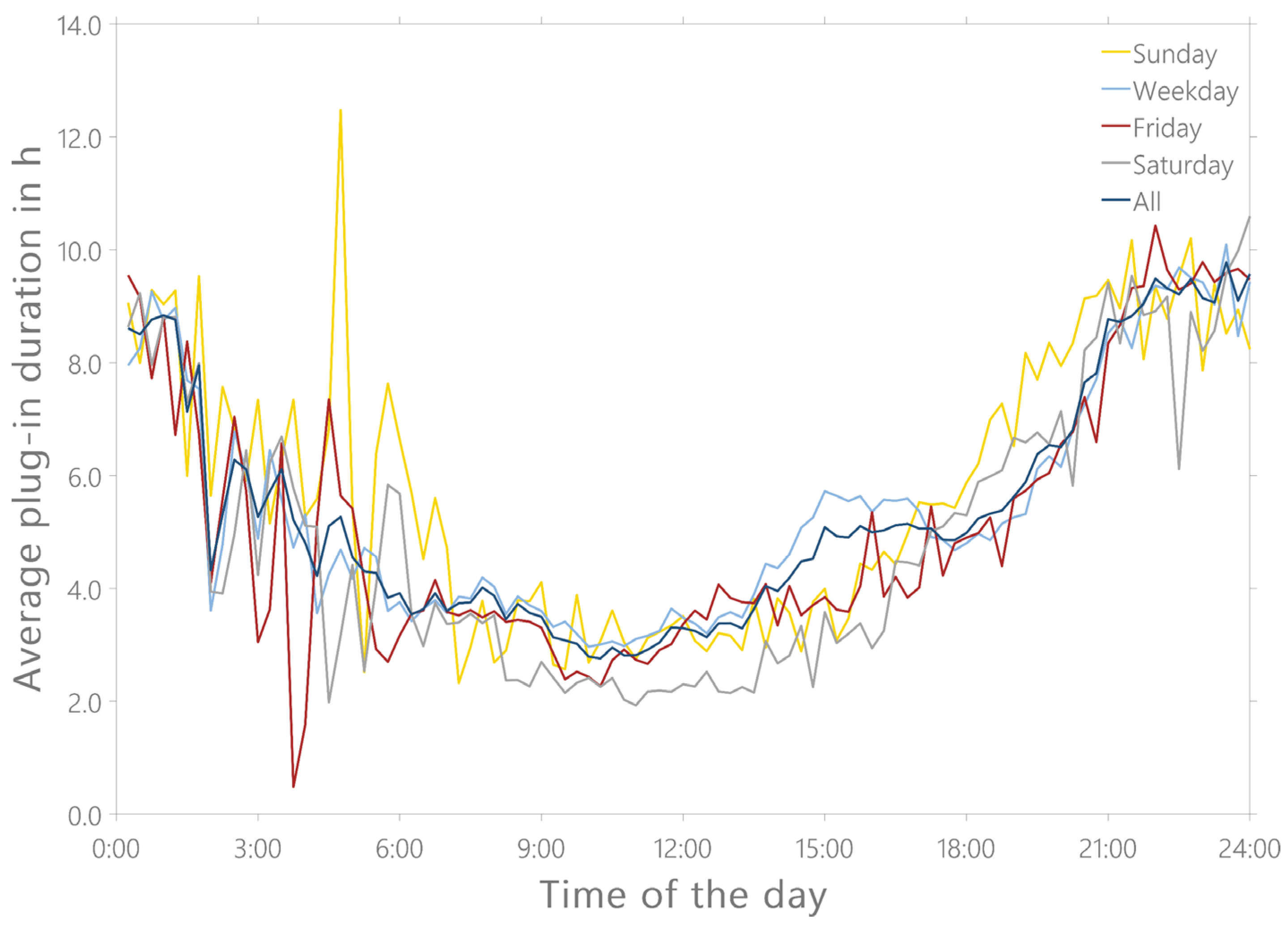
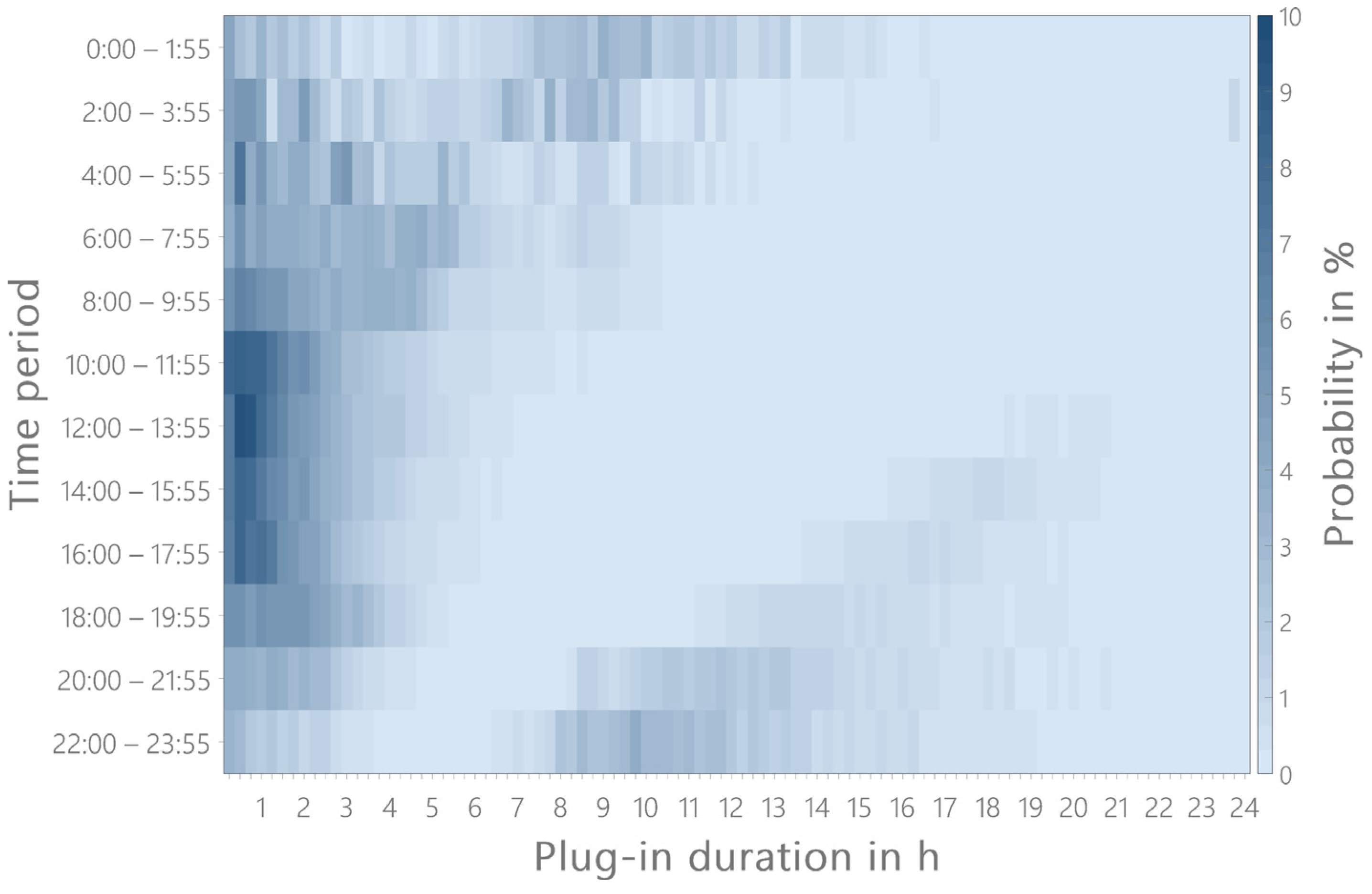
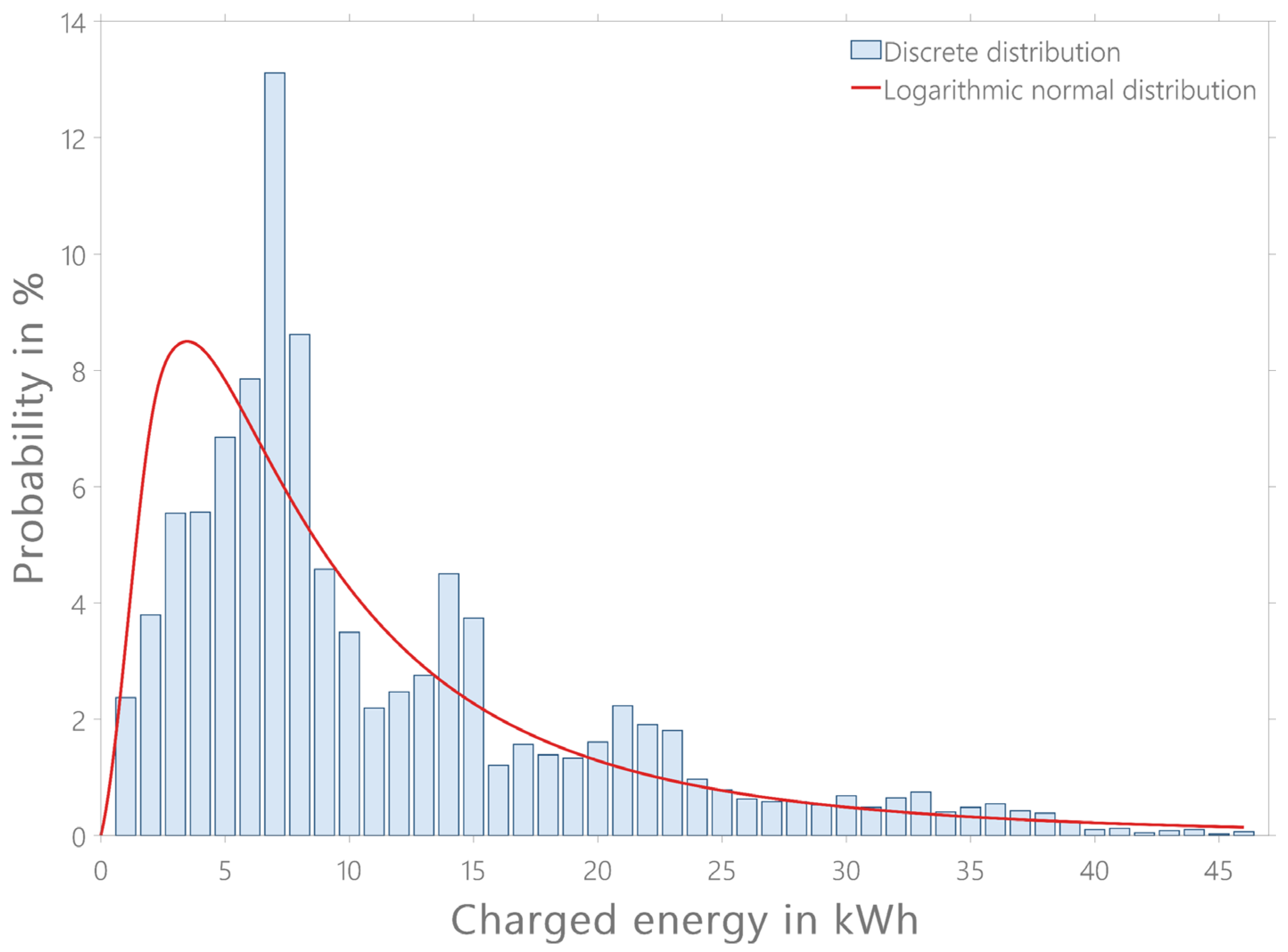
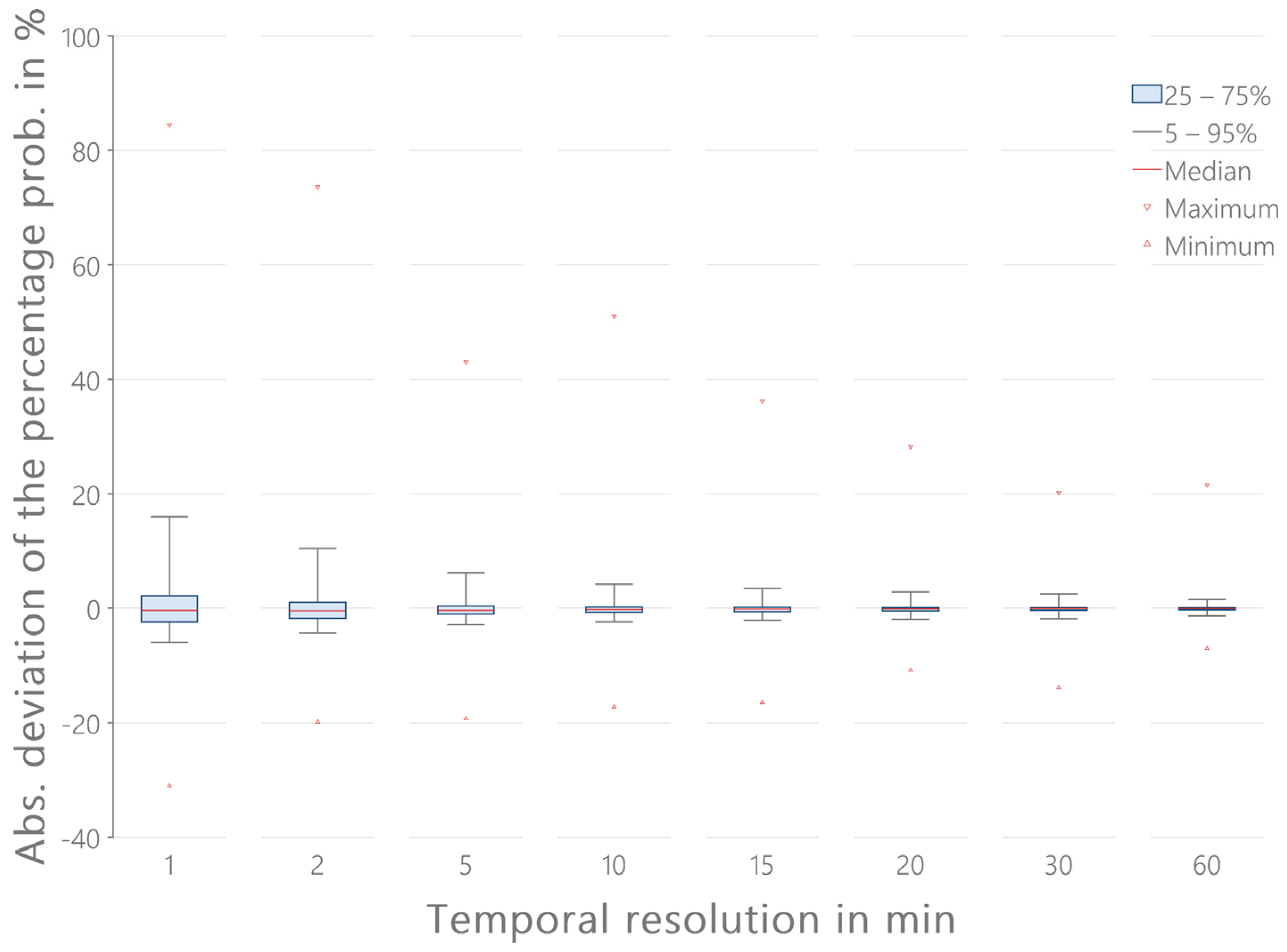
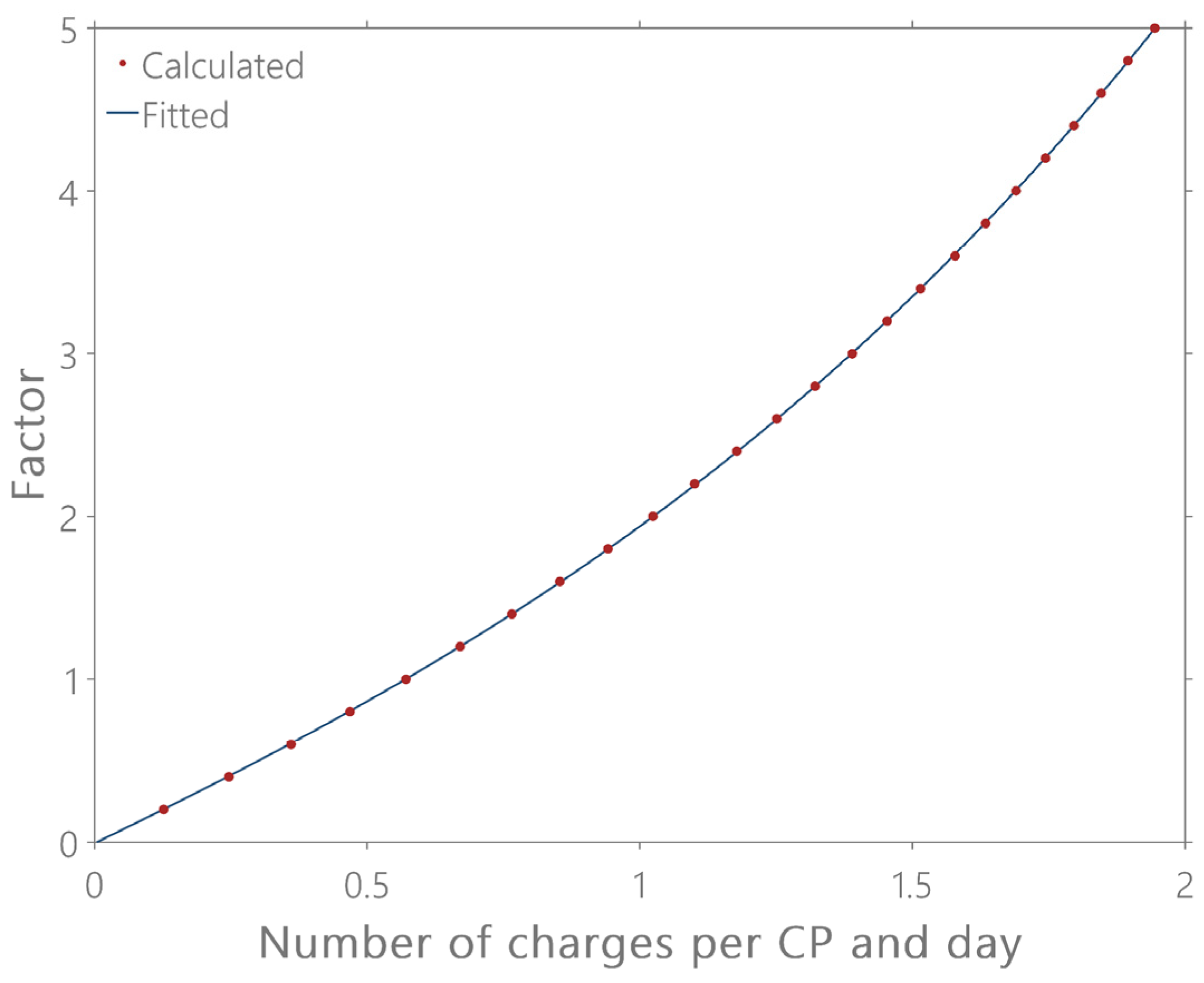
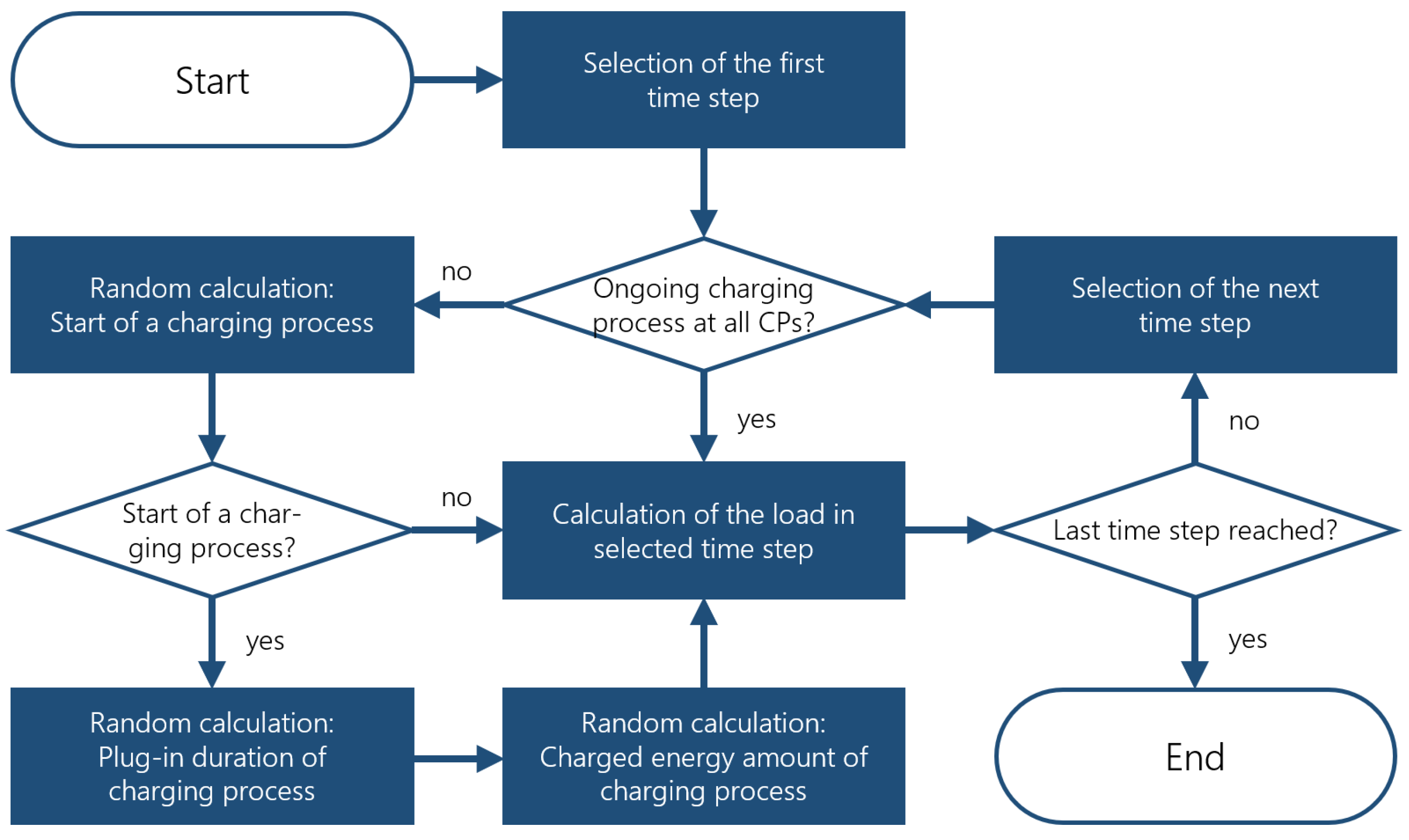
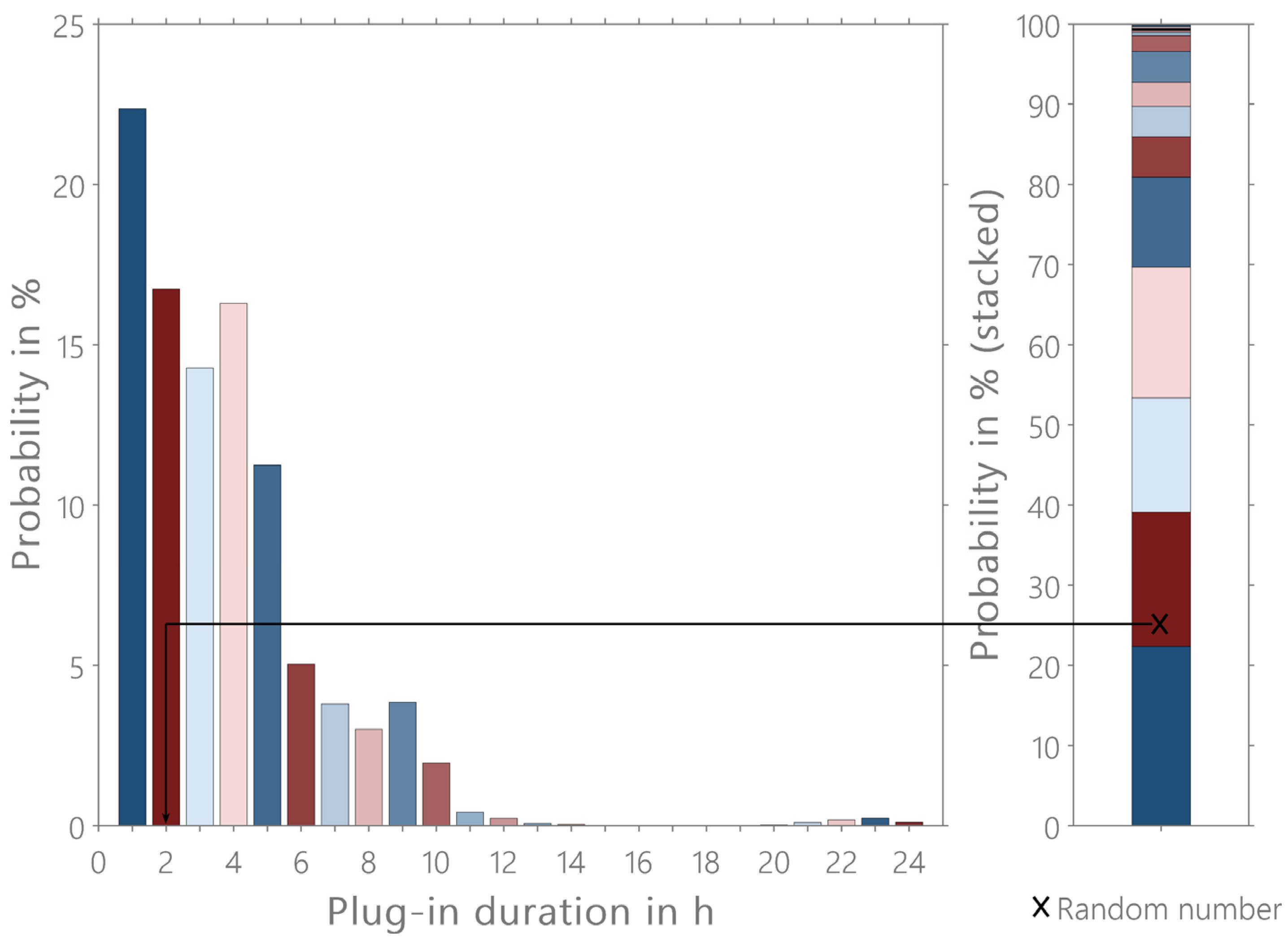
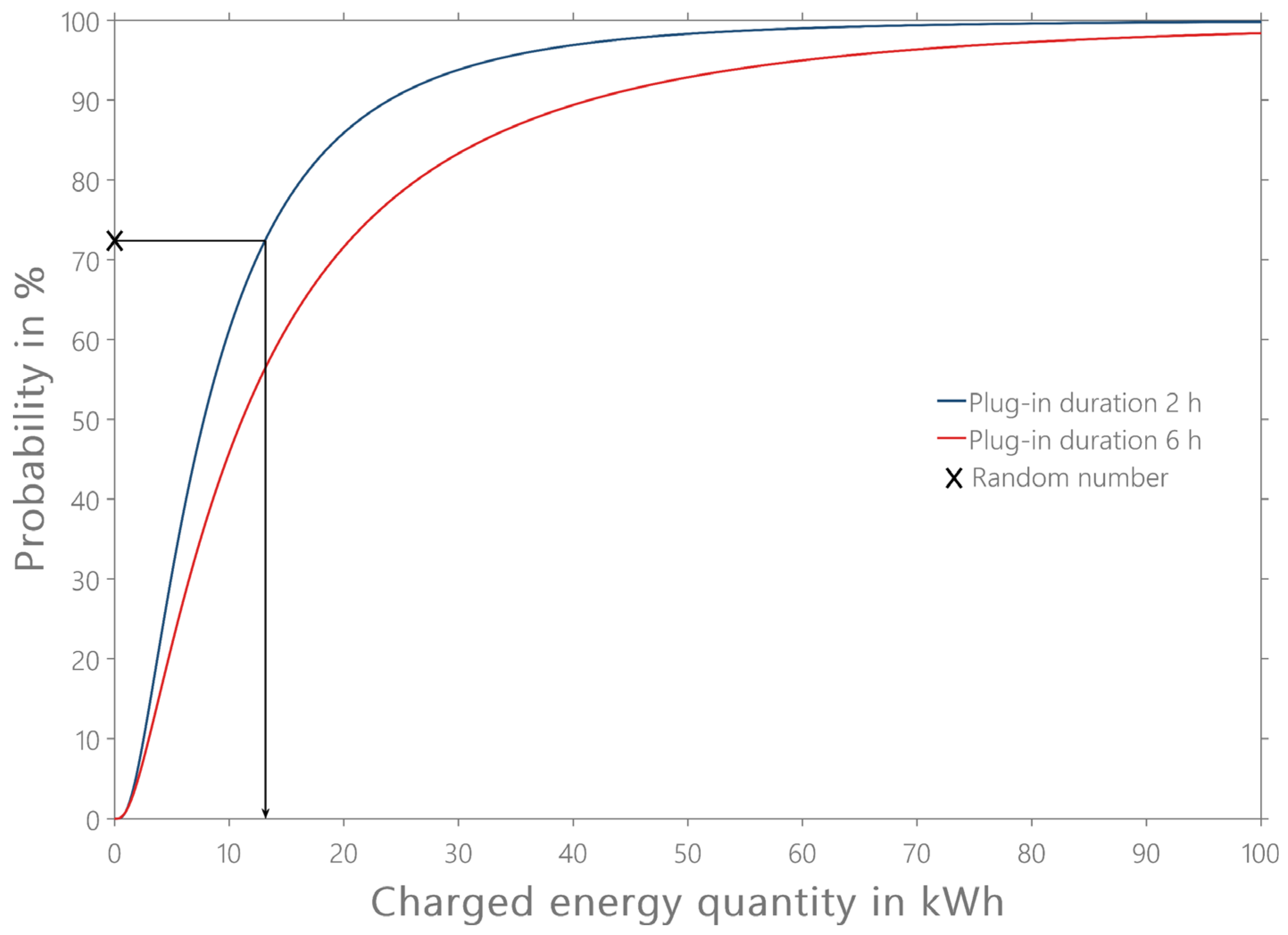
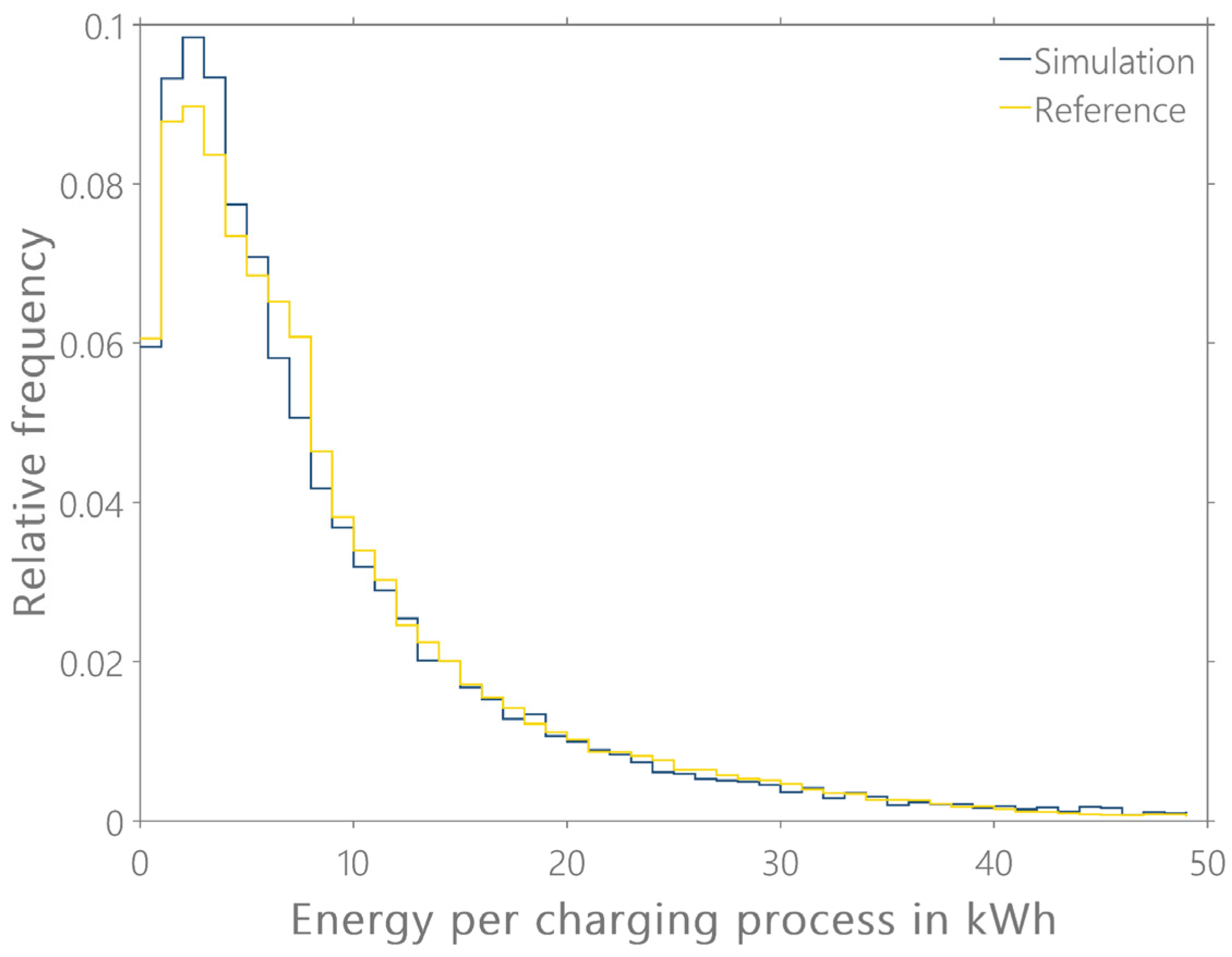
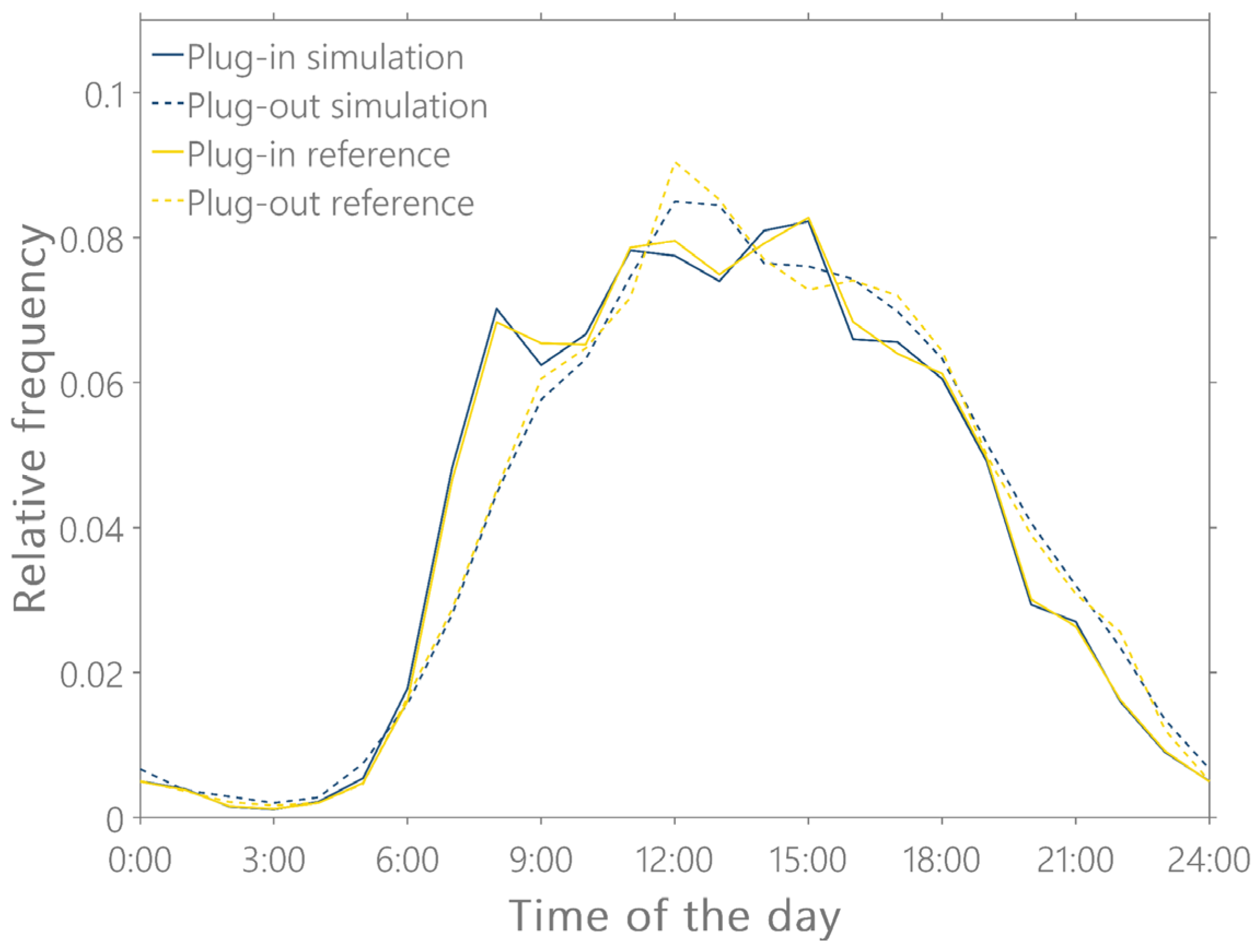
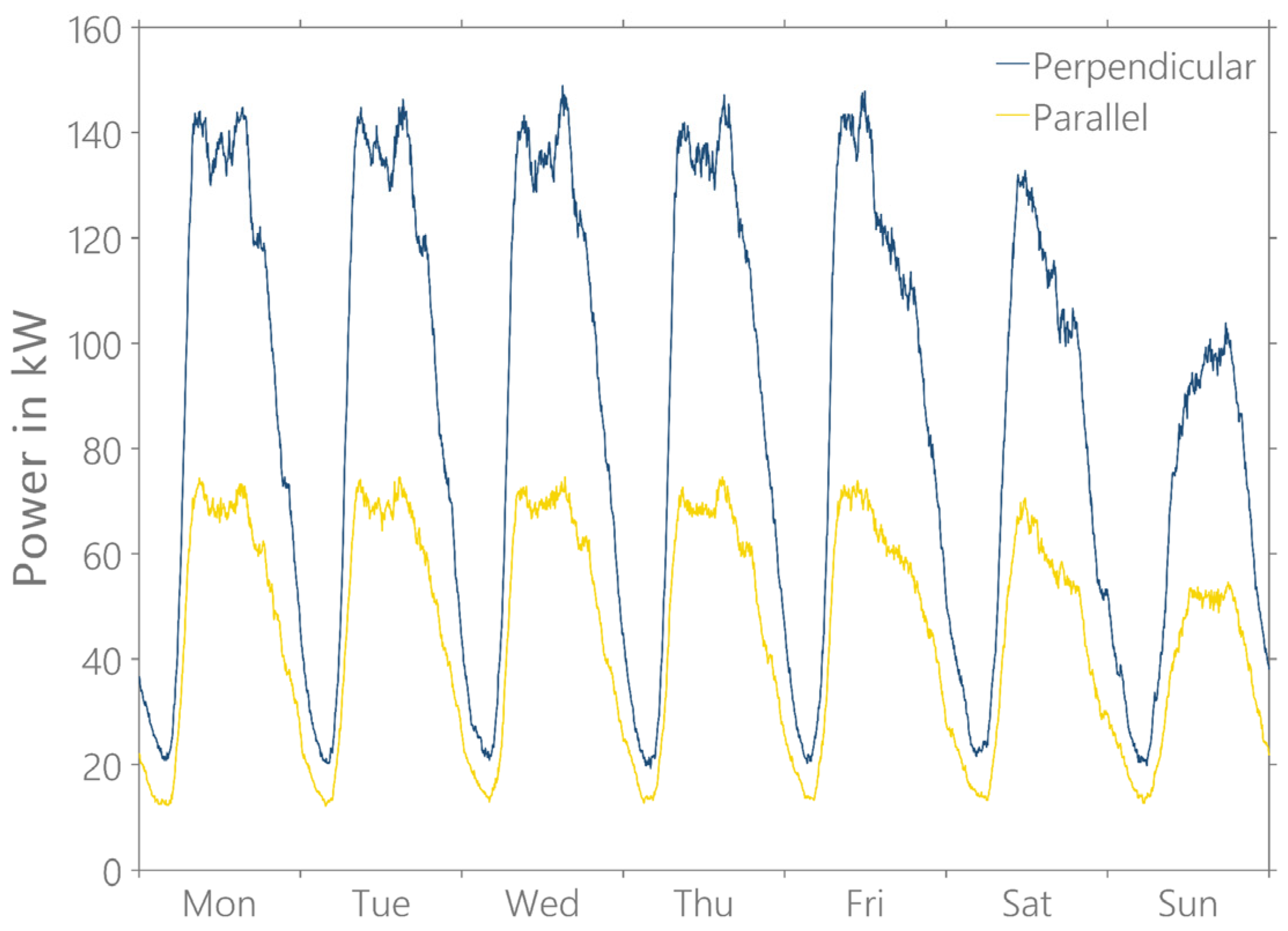
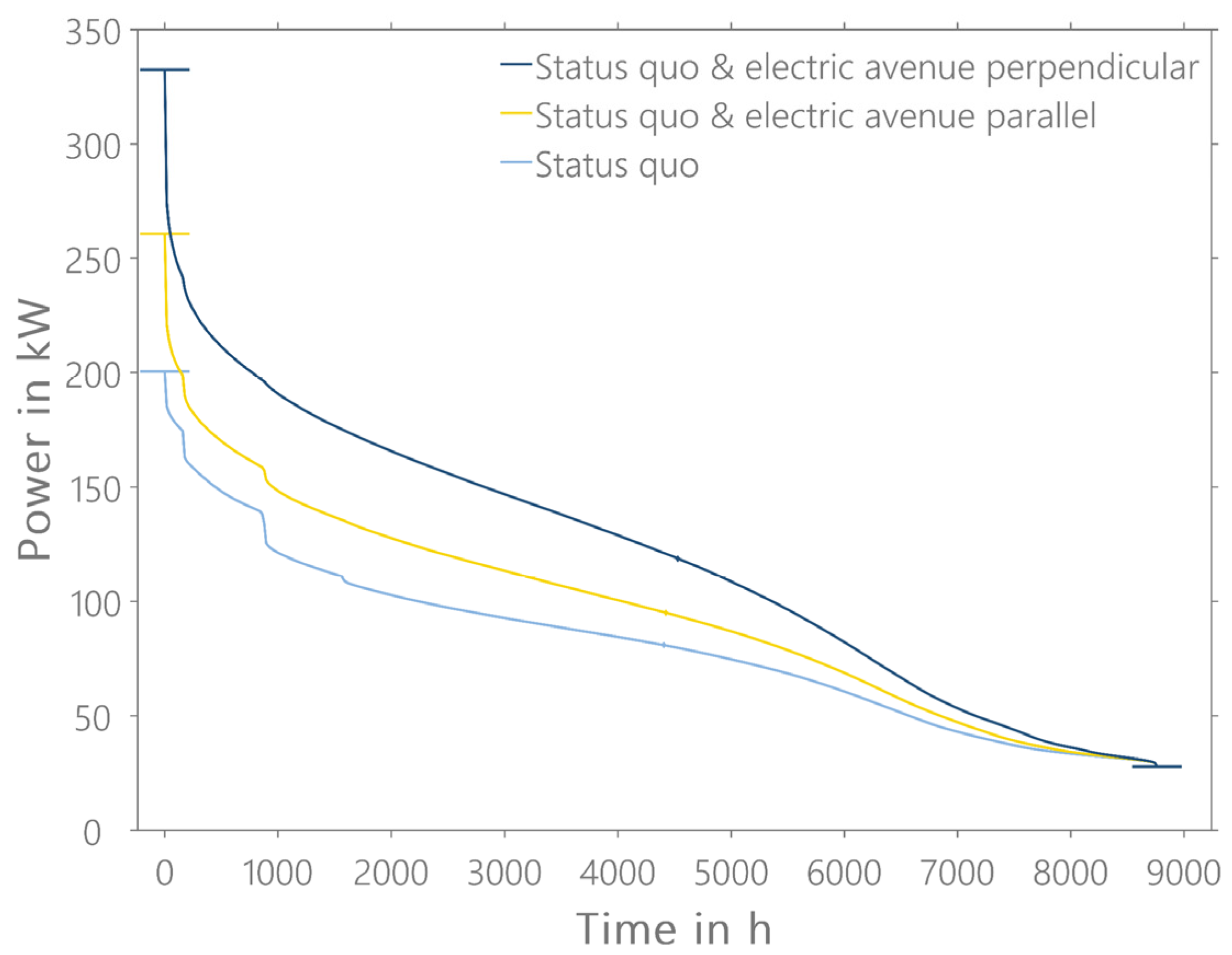
| CPs | Charging Processes | Recording Period | Considered Sites | Plug-In Duration | Charged Energy | Charging Power |
|---|---|---|---|---|---|---|
| 527 | 107,404 | 03/2012 until 06/2020 | Semi-public, Public | 2.5 min to 24 h | 0.1 Wh to 102 kWh | 3.7 kW, 11 kW, 22 kW |
| Day of the Week | Charging Processes | Average Charging Processes per Day | Average Plug-In Duration in h | Average Charged Energy in kWh |
|---|---|---|---|---|
| All | 107,404 | 0.65 | 4.58 | 9.93 |
| Sunday | 9240 | 0.39 | 5.05 | 12.43 |
| Weekday | 68,684 | 0.72 | 4.70 | 9.54 |
| Friday | 16,508 | 0.70 | 4.28 | 9.86 |
| Saturday | 12,972 | 0.55 | 3.99 | 10.34 |
| City Category | Cities in Category | CPs | Charging Processes | Average Charging Processes per Day | Average Plug-In Duration in h | Average Charged Energy in kWh |
|---|---|---|---|---|---|---|
| All | 190 | 527 | 107,404 | 0.65 | 4.58 | 9.93 |
| Large | 34 | 264 | 47,071 | 0.71 | 6.41 | 7.44 |
| Medium | 77 | 182 | 49,383 | 0.68 | 3.12 | 11.99 |
| Small | 59 | 85 | 9896 | 0.46 | 3.41 | 11.50 |
| Municipality | 20 | 21 | 1054 | 0.25 | 2.16 | 10.25 |
| Season | Recorded Seasons | Charging Processes | Average Plug-In Duration in h | Average Charged Energy in kWh |
|---|---|---|---|---|
| All | 2209 | 107,404 | 4.58 | 9.93 |
| Spring | 513 | 23,751 | 4.74 | 9.26 |
| Summer | 493 | 25,520 | 4.69 | 9.54 |
| Autumn | 568 | 35,146 | 4.39 | 10.51 |
| Winter | 635 | 22,987 | 4.58 | 10.17 |
| Characteristic Values | Simulation | Input [25] | Reference [30] |
|---|---|---|---|
| Average number of charges for all CPs and day | 0.72 | 0.20 | 0.72 |
| Average plug-in duration per charge in h | 4.50 | 4.50 | 8.83 |
| Average energy consumption per charge in kWh | 9.8 | 9.49 | 14.00 |
| Number of Strings | Max. String Length | Number of Interconnection Points | Number of CPs at Each Interconnection Point |
|---|---|---|---|
| 4 | 160 m | 4 | 12 (PAA) 32 (PEA) |
| Time Period | Charging Processes | Average Charging Processes per Day | Average Plug-In Duration in h | Average Charged Energy in kWh |
|---|---|---|---|---|
| Before reference day | 2725 | 0.60 | 2.83 | 6.68 |
| After reference day | 2046 | 0.45 | 2.76 | 5.88 |
Publisher’s Note: MDPI stays neutral with regard to jurisdictional claims in published maps and institutional affiliations. |
© 2022 by the authors. Licensee MDPI, Basel, Switzerland. This article is an open access article distributed under the terms and conditions of the Creative Commons Attribution (CC BY) license (https://creativecommons.org/licenses/by/4.0/).
Share and Cite
Weiß, A.; Biedenbach, F.; Müller, M. Probabilistic Load Profile Model for Public Charging Infrastructure to Evaluate the Grid Load. Energies 2022, 15, 4748. https://doi.org/10.3390/en15134748
Weiß A, Biedenbach F, Müller M. Probabilistic Load Profile Model for Public Charging Infrastructure to Evaluate the Grid Load. Energies. 2022; 15(13):4748. https://doi.org/10.3390/en15134748
Chicago/Turabian StyleWeiß, Andreas, Florian Biedenbach, and Mathias Müller. 2022. "Probabilistic Load Profile Model for Public Charging Infrastructure to Evaluate the Grid Load" Energies 15, no. 13: 4748. https://doi.org/10.3390/en15134748
APA StyleWeiß, A., Biedenbach, F., & Müller, M. (2022). Probabilistic Load Profile Model for Public Charging Infrastructure to Evaluate the Grid Load. Energies, 15(13), 4748. https://doi.org/10.3390/en15134748






